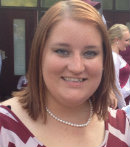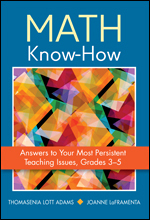Math Answers You Won’t Find Elsewhere
Math Know-How: Answers to Your Most Persistent Teaching Issues, Grades 3-5
By Thomasenia Lott Adams & Joanne LaFramenta
(Corwin, 2014 – Learn more)

Throughout my undergraduate and graduate education, most of the research that I have done has been focused on mathematics instruction. As I approach the end of my graduate education and the beginning of my teaching career, I know that I will have a lot of big questions and concerns that I have yet to anticipate.
I began reading this book with excitement for what it might offer in regards to giving me realistic preparation for the classroom. With its promising title, what math teacher wouldn’t be excited to read this book? And it does offer answers to some of the most difficult questions that authors tend to ignore.

These explanations of important concepts are the strength of the book, rather than actual answers to the questions, which are occasionally brief or missing. Also included in each chapter are summaries, reflection tasks and further questions. The summaries are concise and meaningful, and the reflection opportunities are certainly beneficial for teachers who are serious about improving their practices.
The authors take on critical topics
Perhaps the biggest strength of this book is that the authors take on topics of critical importance in today’s educational society — addressing the Common Core State Standards, making the best teaching decisions, coping with pacing guides, using manipulatives and technology, and finding value in reflection. While I won’t summarize every chapter, I am including information on what I consider to be the most useful chapters in the book.
Chapter 5, which is on differentiating instruction, is a powerful addition to the book. Adams and LaFramenta give readers a good look into what differentiated instruction looks and sounds like in the mathematics classroom. Possibly my favorite part about this chapter is the number of research-based differentiation strategies that are described and referenced.
Any time authors back up their words with research, I become more trusting of their opinions. While I thought this could have occurred more throughout the book, it was a strong and important piece in discussing differentiated instruction. This practical classroom application is just another added benefit of Math Know-How.
The use of manipulatives is important for students in order for them to gain a conceptual knowledge of mathematics topics. Chapter 6 gives an overview of a wide variety of manipulatives and how they can be used during instruction and problem solving. Perhaps the most interesting piece of this chapter is the section on building manipulatives into the classroom routine and how to manage their use.
This step is often overlooked, which can lead to large amounts of frustration when students use the materials inappropriately or don’t keep them organized. With numerous materials being used all at once across the classroom, organization and routine are critical pieces of manipulatives use.
Chapter 7 is full of suggestions on the implementation of technology in the mathematics classroom. While providing helpful insight on traditional technology, such as calculators, this chapter also delves into some newer and more creative forms of technology. Even better, the authors discuss how many of these programs can be adapted to implement in the mathematics classroom. Finally, they end the chapter by discussing the assessment of technology and its connection to Common Core assessment.
Teacher reflection
Most of this book pays particular attention to instruction and teaching practices. Chapter 8, which may be my favorite, focuses solely on the teacher’s reflection process. Reflection is often forgotten or pushed to the bottom of the priority list by teachers of all subjects, but it is of significant importance. The authors spend a considerable number of pages discussing the importance of reflection and how to make connections between the planning, preparation and execution stages and eventual student outcomes. This chapter is probably the most difficult to read, but it is well worth the effort.
Overall, Math Know-How is certainly worth a teacher’s time. While the authors do not necessarily answer every question that is posed, they do discuss important topics that are often bypassed and overlooked. I believe that their perspectives on these topics are refreshing and will be useful for upper elementary teachers at any career stage, whether they specialize in math or teach in self-contained classrooms.
Sarah Parker is a graduate student at Mississippi State University in Starkville, MS. Sarah is working toward a Master’s degree in Elementary Education with a focus in Middle Level Education. After graduation in May 2014, she hopes to teach middle school math, where she will implement her beliefs in teaching mathematics through problem solving, the use of manipulatives, and the integration of writing. Sarah loves exploring mathematics and hopes to instill this passion in her students.


































